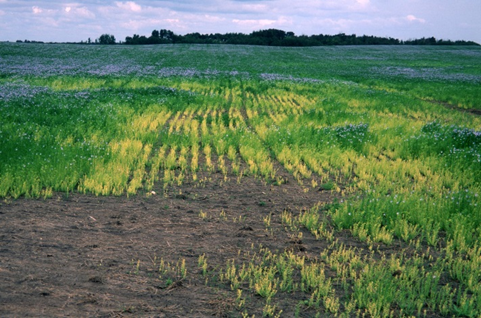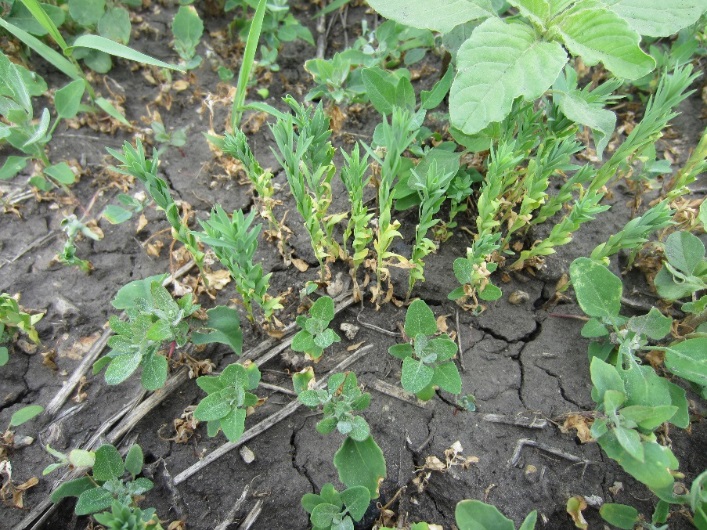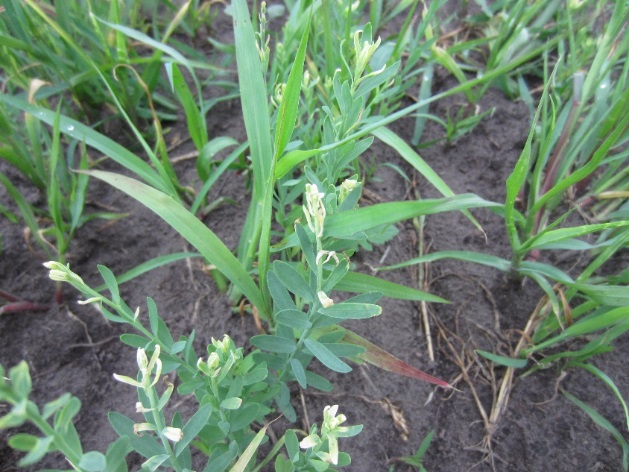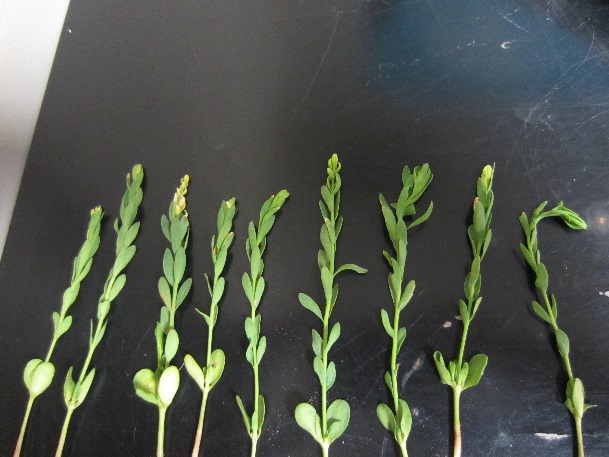Flax TIPS: Emergence Monitoring – What to watch for
Monitoring your flax crop every few days during emergence will determine if your target plant population has been achieved, and if not, help to determine the cause. Scout your fields when flax is emerging, typically 7 – 14 days after seeding. Count the number of plants per square foot in a number of locations throughout your field to get a good perspective of the overall picture. Yield potential is reduced when stands have less than 30 plants/foot2 (300 plants/meter2).
Here are some key issues to watch for in flax establishment and suggestions on how to manage your risk.
Issue 1. Poor Germination and/or Patchy Emergence
What to Look For:
-
Low moisture
Dry spring conditions can cause poor germination and patchy emergence. While it may be tempting to seed into moisture under dry conditions, soil temperature is cooler at increasing depth. As well, research has shown that increasing seeding depth reduces flax emergence. To manage risk under dry conditions, maintain a firm seedbed to maximize soil to seed contact by reducing tillage and/or packing soil depending on your conditions. -
Low seeding rate
The average seedling emergence rate of flax is usually between 50 – 60%, therefore it is important to adjust your seeding rates for seed germination accordingly to ensure a plant population of 30 – 40 plants/ft2. The target seeding rate of flax is typically 40 – 50 lbs./acre. -
Deep seeding
As flax is a small seeded crop, it is important to maintain a shallow seeding depth (1” – 1.5”). If seeded too deep, emergence rates may be reduced and days to emergence will be increased. Where stands are poor, look for seeds that have germinated but have not emerged. To remedy this issue next year, reduce your seeding depth. -
Cutworms
If emergence is patchy, cutworms could be responsible. Scout for cutworms from mid-May to the third week of June. Check for cutworms in the upper 3 – 4” of soil in patchy areas. Look for damaged plants that appear to be severed at the soil surface. Cutworms will generally target higher (drier) areas of the field first. The economic threshold of cutworms in flax is > 4 – 5 larvae/m2, above which an insecticide may be warranted. If the cutworm population is high in your field, damage to your flax stand may occur within days and can be extensive. -
Poor quality or cracked seed
To ensure adequate plant stands, always plant using high quality flax seed with high germination. The use of pedigreed seed is encouraged. Factors that may decrease emergence may include weathered seed, cracked seed, disease infected seed or residual herbicides (e.g. fall applications of glyphosate may result in lower germination of harvested seed). If unsure, send your seed samples to a seed lab to determine germination potential, seedling vigor, pathogen levels and presence of seed residual herbicides.Flax seed is susceptible to cracking (especially if seed is very dry) if fan speeds on seeders are set too high. Check your manufacturer’s settings and adjust fan speeds accordingly.
-
Fertilizer damage
Flax is sensitive to seed placed fertilizer. The rule of thumb is not more than 15 lbs. / acre of P2O5 and no nitrogen fertilizer should be placed with the seed. Research has shown that the optimum placement of fertilizer for flax is in a side-band or mid-band.
Issue 2. Yellowing Leaves
What to Look For:
General or Uniform Pattern in the Field
-
Chlorosis
Flax is more sensitive to zinc deficiencies than other crops, which may cause “chlorotic dieback” or zinc chlorosis (yellowing of leaves). If plants recover, they will usually have delayed maturity. Excessively wet, calcareous soils are more susceptible to zinc and iron chlorosis.Look for irregular patterns of chlorosis in the field (Figure 1). If you know that your soil conditions may result in zinc chlorosis, consider soil testing and the use of fall or spring applications of zinc. Foliar applications of zinc once symptoms have shown up in the field may help to alleviate symptoms of zinc chlorosis. Zinc fertilization could be beneficial at seeding before symptoms develop in fields that have a history of chlorosis.
Flax can grow out of iron chlorosis if wet conditions are alleviated. Prevention of iron chlorosis may be achieved by better drainage. AC Emerson, if commercially available in your area, is more tolerant to iron chlorosis than other varieties.
-
Fusarium wilt
Fusarium wilt is a soil borne pathogen that invades the root at any growth stage. At the seedling stage look for plants that are yellowing, eventually browning, with roots turning ashy grey (Figure 2). A soil sample can confirm the presence of this disease. Spores may exist in the soil for up to 10 years. Ensure proper rotation intervals between flax crops to prevent this disease.
Irregular Pattern in the Field
-
Extreme wet conditions
As flax is relatively shallow rooted, it is more sensitive to extreme moisture conditions (drought or excess moisture). Seed flax on well drained soils. -
Nutrient deficiency
Ensure there is adequate balanced fertility based on soil test recommendations calculated for a reasonable target yield. -
Seedling blight or root rot
Blighted seedlings turn yellow, wilt and die. Seedling blight may occur as single plants, patches or gaps in the row. Roots of blighted plants will have red or brown lesions, appear dark and shriveled. To prevent seedling blight, use certified seed, seed treatment, prevent seed cracking at seeding and use proper rotation intervals.
Issue 3. Wilted Plants
-
Frost damage
Flax is relatively resistant to frost damage. Emerging (cotyledon stage) plants can tolerate up to approximately -3° Celsius. Once your flax crop is at the two leaf stage, it can tolerate up to approximately -8°C for a short time, if hardened first. “Hardening” refers to plants that have experienced cooler temperatures over the past week or two before a frost. Plants are more susceptible to frost when wide swings in temperatures occur.
Issue 4. Stunted Plants
-
Extreme wet or dry weather
Flax has a relatively shallow root system making it more sensitive to extreme changes in soil moisture (Figure 3). -
Herbicide injury
Dry soils this spring may exacerbate the risks from soil residual herbicides. Climatic conditions play a considerable role in determining the speed of herbicide breakdown in soils. If conditions have been dry, soil microbial populations can cease all activity, drastically reducing herbicide breakdown. For re-cropping restrictions with residual herbicides, please refer to last month’s TIP article entitled “Seeding Advice”. If the specific herbicide history is unknown, it is possible to send soil samples for residue analysis to an accredited lab.Also use caution when applying herbicides to nearby crops, as flax is sensitive to herbicide drift (Figure 4).
-
Poor weed control
Flax can become stunted when faced with significant weed pressure. Be certain to control weeds early for optimum efficacy. Spraying in-crop broadleaf herbicides later than when flax is 4” in height can result in significant damage to your flax crop. For maximum yield, it is important to maximize the number of days between the emergence of the flax crop and the emergence of weeds.
When to Reseed?
Long term data from Manitoba Agricultural Services Corporation indicates there is a reduction of yield below 30 plants/ft2 (300 plants/m2). However, even at plant stands as low as 10 plants/ft2 (100 plants/m2), yields were reduced only about 20%, as extensive tillering compensated for the lower stands. However, note that flax varieties vary for capacity to tiller. Decisions to reseed should always consider cost of reseeding, timing, environmental conditions against risk of yield loss and harvest delays.
References and Other Resources:
The Flax Production Guide https://archive.flaxcouncil.ca/growing-flax/introduction/
Manitoba Agriculture, Food and Rural Development https://www.gov.mb.ca/agriculture/crops/production/flax-and-solin/index.html







